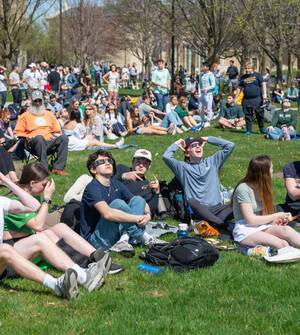 "
"
Spring in South Bend is always a gamble. Within a given April week, a Notre Dame student could be met with scorching 80 degree weather, a torrential downpour with 45 mph wind gusts and, yes, even a snowstorm that necessitates dusting off the parka that was prematurely put in storage. Monday, April 8, 2024 was one of those picturesque spring days that reinvigorates everyone’s spirits, much needed after having endured the bitter cold and permacloud for months. On those sorts of days, the Notre Dame campus transforms into a quintessential, promotional-magazine-worthy “college” scene, complete with spontaneous appearances of lively spikeball games and sprawled-out students reading books on beach towels on the grassy quads. On this particular day, though, throngs of Notre Dame students gathered on the quads for an extraordinary — potentially once or twice in a lifetime — reason: A total solar eclipse was busy making its way across North America, passing over Mexico, the United States and Canada. Lucky for Notre Dame, South Bend was in the path of the eclipse and set to experience 97% totality at precisely 3:09 p.m. Dr. Keith Davis, associate professor in the Notre Dame Department of Physics and Astronomy and director of the Digital Visualization Theater, spearheaded many of the events that took place leading up to and during the solar eclipse. “We did a series of talks, some of which were at the public library downtown. A couple of other professors did some other activities around the local area. There was a lot of public interest, which was exciting,” Dr. Davis explained. Some of the talks — which were free and open to the public — covered the history of eclipses, the science behind them and how to safely view them. As for the actual day of the eclipse, Dr. Davis and his colleagues planned a public Eclipse Watch Party, which took place on the Irish Green and in the DeBartolo Performing Arts Center and lasted from 1-4:30 p.m. “We took six of the telescopes we use for teaching ... and set them up on Irish Green with solar filters on the front of them ... We had a tent set up with a television so we could see totality happening in other places, ” Dr. Davis said. The Philbin Studio Theater was reserved as an indoor refuge for people who wanted a break from the sun or to watch the NASA livestream of the eclipse. Dr. Davis surmised that this particular watch party was attended by “several thousand people.” Given all the advanced preparation that went into this event, Dr. Davis shared that, when he finally managed to break free from supervising the telescopes, “it was really quite gratifying to turn around and see all the people.” All around campus, the cadence of a typical Monday seemed to fade away just before the clock hit 3 p.m. Although there could have been a few sticklers, most professors graciously canceled afternoon classes. As the moment of almost maximum totality approached, what had been a bright and clear 70 degree sky seemed to be getting increasingly dimmer — although still decidedly daylight — and cooler. Thousands of students gathered in outdoor spaces, lounging in beach chairs and tossing frisbees as speakers blasted “Here Comes the Sun” and “The Final Countdown.” The anticipation was palpable: what exactly was going to happen nine minutes past three? Everyone fumbled to put on their eclipse glasses, stared up at the sky and for a couple minutes were met with a magnificent sliver of sun peeking out from an otherwise darkened sphere. Ninety-seven percent totality wasn’t enticing enough for all Notre Dame students to stay put in South Bend. “The sun is so bright that any little bit of it being visible is enough to get it pretty close to daytime,” Dr. Davis said, explaining the sharp contrast between full totality and anything less than that. Some students opted to drive to other parts of Indiana or Ohio that fell along the 115-mile-wide path of totality. Sophomore Jack MapelLentz — self-identified map enthusiast — found a random location on Google Maps in Eaton, Indiana called the Granville Artesian Well, and drove there to experience totality. “I don’t think I was able to fully process how incredible it was at the time,” Jack said. “I might just become one of those eclipse chaser people now.” While it’s true that South Bend being this close to the path of totality is a rare occurrence, total solar eclipses “are more common than people tend to think, because you’re only aware of the ones that are happening where you are,” Dr. Davis emphasized. So, feel free to wait until 2099 to experience full totality in South Bend ... or, hop on a plane to Iceland for the 2026 eclipse!